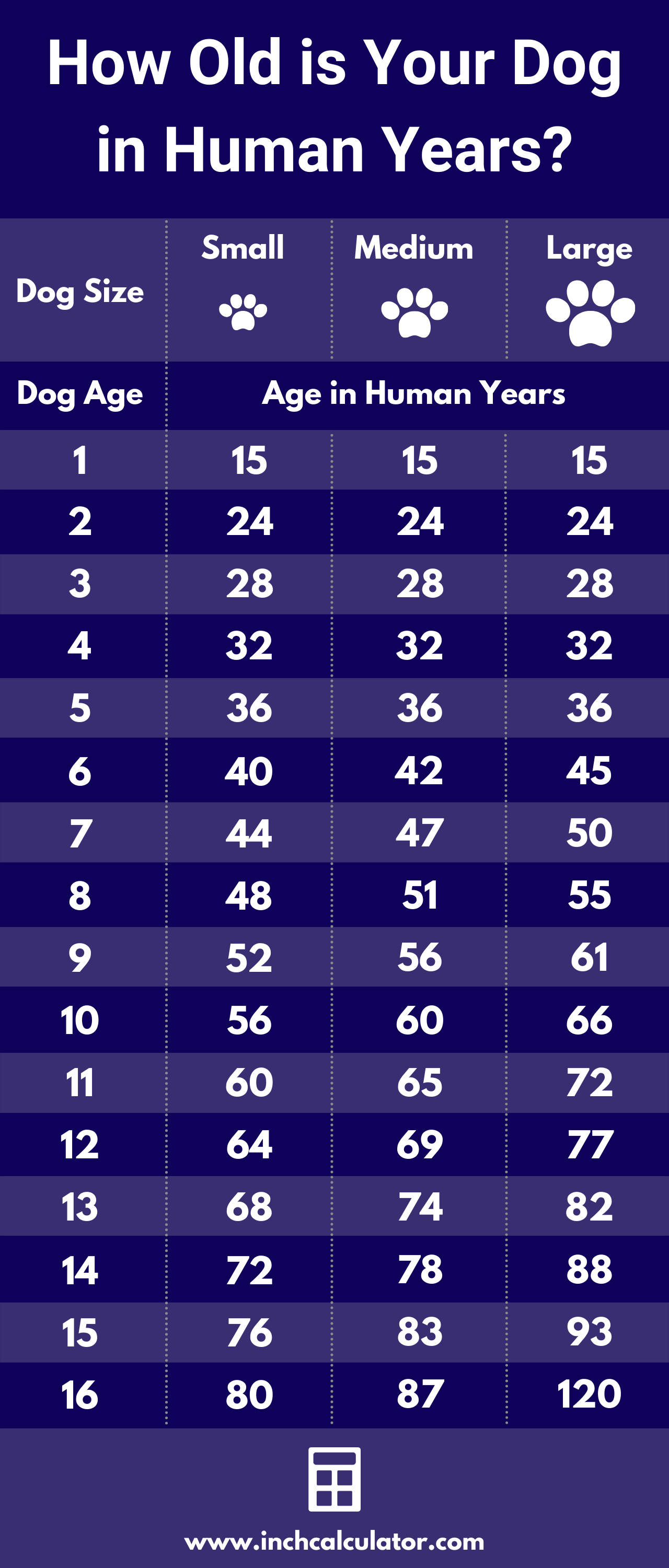Dog Age Calculator – Dog Years to Human Years by Breed
Enter your dog’s age in years to calculate their age equivalent to human years.
Equivalent Human Years:
On this page:
Hold Old is My Dog? Here’s How to Calculate It
At some point, you’ve most likely heard that one dog year is equivalent to 7 years for a human. Despite the widespread use of this formula, it’s been debunked by science time and again.

Dog Aging Explained
Methylation is a process that affects gene expression in an organism’s DNA (turning genes of or on).[1] By studying the rate of methylation, it’s possible to understand the aging process better.
In a study, geneticists have been able to uncover a more accurate formula for measuring the age of a dog. They discovered that aging milestones in dogs don’t accurately match up with humans, and the dogs age much more quickly in their first year or two, but then the aging process slows significantly and may even match the human aging process in their later years.[2]
Dog Age Formula
So if it’s not 7 dog years per human year, then how do you calculate your pup’s age in human years? Unlike finding your own age, you’ll need to use a formula to find the equivalent age in human years.
There are a few formulas to approximate a dog’s age in human years.
Formula One: The AVMA Method
The first method is to use the guidelines from the American Veterinary Medical Association, which are:[3]
- The first year of a puppy’s life is equivalent to 15 human years
- The second year is equivalent to 9 additional human years
- Each year after is equivalent to 4-5 human years
Formula Two: The University of California Method
An alternative method for estimating a dog’s age in human years was suggested after a recent study by researchers at the University of California San Diego, which found the following formula closely approximates a dog’s age in human years.
equivalent human age = 16ln(dog age) + 31
Thus, the equivalent human age is equal to 16 times the natural log of the dog’s age, plus 31.[4] To calculate the natural log, you can use a scientific calculator; enter the dog’s age, then press the “ln” button.
To find the dog’s age in human years, simply enter the dog age in the formula and solve.
This formula is based on a recent scientific study of 104 Labrador Retrievers. Admittedly this study only covered a single species, and it’s commonly thought that the aging process in dogs varies among breeds. However, it’s still much more accurate than multiplying the age by 7.
Breed and Size Affects Aging
It’s important to note that the result of using these formulas is an estimate only, and there are several other factors that impact how dogs age.
Larger breeds age more quickly than smaller breeds, which tend to live longer than their larger counterparts.[5] It’s not known for sure why this is, but some think the shorter lifespan is likely due to the accelerated growth process in larger breeds.
Dog Age Chart
The chart below shows dog years to human years accounting for the size of the dog, according to WebMD.[6]
| Dog Age | Age in Human Years | ||
|---|---|---|---|
| Small (0-20 lbs / 0-9 kg) |
Medium (21-50 lbs / 10-23 kg) |
Large (51+ lbs / 24+ kg) |
|
| 1 | 15 | 15 | 15 |
| 2 | 24 | 24 | 24 |
| 3 | 28 | 28 | 28 |
| 4 | 32 | 32 | 32 |
| 5 | 36 | 36 | 36 |
| 6 | 40 | 42 | 45 |
| 7 | 44 | 47 | 50 |
| 8 | 48 | 51 | 55 |
| 9 | 52 | 56 | 61 |
| 10 | 56 | 60 | 66 |
| 11 | 60 | 65 | 72 |
| 12 | 64 | 69 | 77 |
| 13 | 68 | 74 | 82 |
| 14 | 72 | 78 | 88 |
| 15 | 76 | 83 | 93 |
| 16 | 80 | 87 | 120 |

If you have a puppy, see how big they will get using our puppy weight calculator.
How to Estimate a Dog’s Age
If you adopted a dog or puppy and aren’t sure how old they are, then their teeth might give you some clues to their age. Although every dog and breed is different, here are some rough guidelines for aging a dog using their teeth.
8 weeks: baby teeth are in
7 months: adult teeth are in and should be white and clean
1-2 years: teeth begin to look dull and may begin yellowing
3-5 years: teeth are showing tartar build-up and wear
5-10 years: teeth are showing wear and possibly signs of disease
10-15 years: teeth are heavily worn and some may be missing
A veterinarian can give a more accurate assessment after a physical exam, but it will not be possible to completely accurate birthdate. The above signs will be altered if the teeth are cleaned at their vet, and for oral as well as organ health, the dog needs regular dental care.
Curious about how to calculate the age of a cat? Try our cat age calculator.
References
- Theresa Phillips, Ph.D., The Role of Methylation in Gene Expression, https://www.nature.com/scitable/topicpage/the-role-of-methylation-in-gene-expression-1070/
- Jason Daley, Calculate Your Dog’s Age With This New, Improved Formula, Smithsonian Magazine, https://www.smithsonianmag.com/smart-news/theres-new-better-formula-calculating-dog-years-180973575/
- American Veterinary Medical Association, Pets age faster than people, https://www.avma.org/sites/default/files/resources/PetsAgeFasterPoster.pdf
- Tina Wang, Jianzhu Ma, Andrew N. Hogan, Samson Fong, Katherine Licon, Brian Tsui, Jason F. Kreisberg, Peter D. Adams, Anne-Ruxandra Carvunis, Danika L. Bannasch, Elaine A. Ostrander, Trey Ideker, Quantitative translation of dog-to-human aging by conserved remodeling of epigenetic networks, https://www.biorxiv.org/content/10.1101/829192v1.full
- American Kennel Club, How to Calculate Dog Years to Human Years, https://www.akc.org/expert-advice/health/how-to-calculate-dog-years-to-human-years/
- Annie Stuart, How to Figure Out Your Dog’s Age, WebMD Veterinary Reference, https://www.webmd.com/pets/dogs/how-to-calculate-your-dogs-age


